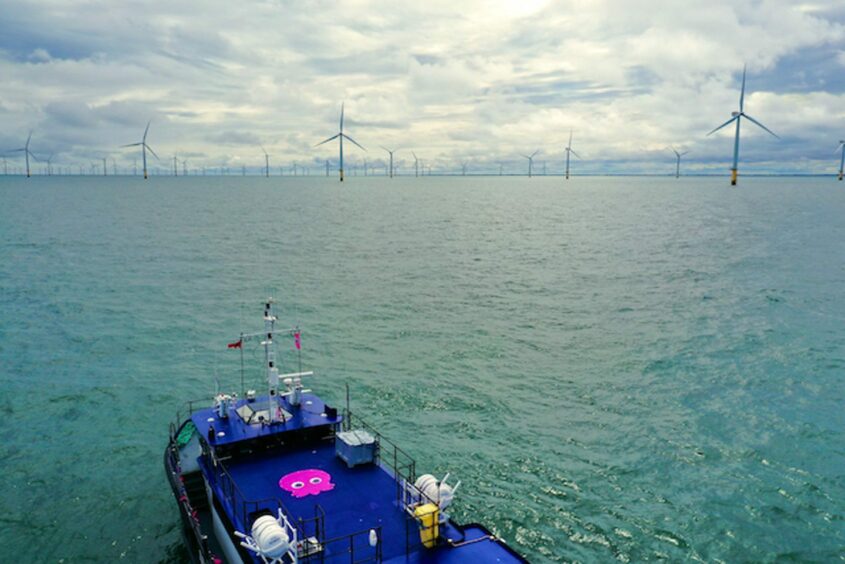
The cost of shutting down wind farm turbines has “snowballed” to £1 billion, according to recent data.
And the issue, which means costs are often passed on the consumers, is only getting worse, according to UK renewable energy supplier Octopus.
Alex Brierley, co-head of Octopus Energy Generation, has told Energy Voice that “the future looks worse” for wind curtailment unless action is taken.
The UK’s biggest renewable electricity supplier said on Friday that it is exploring the use of artificial intelligence as a tool for maximising distribution network capacity as more renewable power comes online.
The cost of wind curtailment is acute now that renewable electricity is now over 40% of the energy mix.
The amount of wind power lost due to wind power curtailment has more than tripled in five years, from 1,855 gigawatt-hours to 6,634 GWh of lost wind energy so far this year, costing producers £1 billion.
“The issue has snowballed – five years ago we turned off 1855GWh of wind,” Brierley told Energy Voice. “The future looks worse if we don’t change.”
The latest figures from data platform Elexon Insights show that the UK lost £1 billion in excess wind power this year, to date, due to a policy of requiring wind farm operators to turn off turbines at times of peak supply.
That data indicates that 6,634 gigawatt-hours of wind power has been lost so far in 2024.
This is nearly double the 3,785 GWh of wind energy that was lost last year, amounting to £779 million, as wind farms were turned off while gas, including imports, met supply demand.
Clem Cowton, Director of External Affairs at Octopus Energy Group, said: “The outdated rules of our energy system mean vast amounts of cheap green power go to waste.
“It’s absurd that Britain pays Scottish wind farms to turn off when it’s windy while simultaneously paying gas power stations in the south to turn on. We need to change the rules that govern our system to make the most of our homegrown energy and get bills down for British households and businesses.”
Zonal pricing
The main solution posed by Octopus is zonal pricing, a regional pricing model for electricity that the company has said is “needed for an efficient and reliable net zero power system”.
Regional pricing could avoid a market skewed by a single wholesale price, which Octopus has said gives the “wrong price signal to low carbon flexible assets” that are more easily sold cheaply when it is in copious supply.
Octopus has previously warned that reforms to the wholesale market could harm public support for net zero “if constraint payments continue to plaster the headlines”.
In June, the renewable electricity supplier’s chief executive and founder Greg Jackson advocated for regional energy pricing to prevent the need for the UK to import electricity.
He called it “outrageous” that there were wind farms that stopped production “at times” while the country imported power from Norway.
The solution he posed was regional pricing, which he said would make “every region cheaper than it is now” and eliminate wasted electricity. Octopus boss says bills should be lower for those closer to wind farms
Forecasts quoted by the supplier suggest that zonal pricing could save the average household nearly £600 over a 16-year modelled period and could be higher the more flexible consumers can be around consumption.
Artificial Intelligence
National Grid Electricity Distribution and Octopus Energy said they are collaborating with developers to “test solutions for accelerating distribution grid connections”.
Octopus has previously said that “activation of intelligent demand must be embedded and enabled across all assets” to keep system costs low.
The electricity supplier has already rolled out a scheme to pass on 1 GW of shiftable electricity capacity to electric vehicles connected to its tariff through Intelligent Octopus Go to reduce demand on the grid at peak times.
The electricity distribution network operator said it has been working with Octopus Energy and AI grid intelligence software company Voltquant, to “develop an AI tool for testing solutions”.
Voltquant said it believes that AI “is the catalyst for revolutionising energy infrastructure”, based on a large-language model, which the companies said, “demonstrates the emerging digital capabilities in the connections space”.
Max Forshaw, grid transformation lead at Octopus Energy, said: “Whilst top-down reform is important, finding ways to maximise distribution network capacity by crowding in new renewable projects will be crucial to achieving the Clean Power 2030 target.”
Zonal pricing models
In its response to the government’s most recent consultation on the Review of Electricity Market Arrangements, exploring wholesale and investment support reforms, Octopus said the benefit would be that electricity would be produced locally to where it is needed.
A zonal pricing model would involve splitting the market into different zones in which consumers would pay different prices for electricity depending on where they lived.
Octopus argues that such a model would give areas with plentiful renewables generation, like in Scotland, some of the “cheapest electricity in Europe”.
Batteries and interconnectors can also “lower system costs” by making renewable power available when needed, according to Octopus.
“Periods with lots of wind should signal cheaper electricity prices for consumers to charge their electric vehicles, for instance, but currently the opposite often happens,” Tom Luff, practice manager for electricity markets and policy at Energy Systems Catapult, has said.
“A plan based on current market data will under-estimate the potential for flexibility and innovation to help us meet our decarbonisation aims quickly and affordably.”
The energy supplier has claimed that its consumers would have saved £3.9bn in the past year with zonal pricing. A regional pricing system would save enough green energy to power 460,000 households each year by avoiding “switching it off” when too many green electrics are generated.
According to Energy Systems Catapult, Australia and Denmark already offer zonal markets.
The UK government has proposed to end curtailment of wind farms through a long-term measure of power links that can export excess electricity to other countries.
It plans to do this through by exporting power internationally through a multi-purpose interconnector.
The energy system operator has previously said that an eight-fold at least increase in investment is needed in the eight years towards 2030, but has consistently fell short of plans.
The National Policy Statement for Renewable Energy Infrastructure from January 2024 said international interconnectors that enable “direct power flow from wind farms” to at least two countries would limit “the need to curtail offshore wind generation when domestic demand has been met by providing a direct route for export to neighbouring North Sea countries”.

 © Supplied by Octopus Energy
© Supplied by Octopus Energy © Supplied by Octopus Energy
© Supplied by Octopus Energy